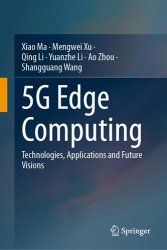 Название
Название: 5G Edge Computing: Technologies, Applications and Future Visions
Автор: Xiao Ma, Mengwei Xu, Qing Li, Yuanzhe Li
Издательство: Springer
Год: 2024
Страниц: 209
Язык: английский
Формат: pdf (true), epub
Размер: 29.5 MB
Edge computing has been identified as one of the key technologies for 5G networks and beyond due to two prominent advantages: low network latency and reduced core network load. By empowering cloud capabilities and IT service environments at the network edge, edge computing can well support applications of 5G and beyond, such as augmented/virtual reality (AR/VR), vehicular network (ultra-reliable low-latency communication services),Internet of Things (massive machine type communication services), and mobile high-definition video (enhanced mobile broadband services). Therefore, edge computing has attracted the attention of both industry and academia since its emergence.
In specific, the book is important for the research community for the following four reasons. First, we present the first comprehensive measurement study on a leading public edge platform, and critical concerns on edge computing are studied in depth through passive-active integrated measurements (Chaps. 2–3). The dataset is open-sourced, which will benefit researchers and practitioners of edge computing and cloud computing significantly. Second, following the measurement results, several key technologies of 5G edge computing are investigated to improve the quality of experience for end users, and optimize the system performance/minimize system cost for edge service providers (Chaps. 4–7). Third, this book explores the integration of edge computing with 5G networks. We implement an end-to-end edge computing system following the 5G standard 3GPP TS 23.501, which supports edge functions such as edge service migration (Chap. 8). Fourth, this book discusses visions of edge computing in the future 6G networks and presents our pioneering exploration (both research and practice) toward edge computing in the 6G era (Chap. 9).
To achieve Internet of Everywhere, satellite communication, unmanned aerial vehicle (UAV) communication, and maritime communication will be integrated and work as a supplement of terrestrial communication. Introducing multiple access network technologies sets higher requirements for 6G core network since it should adapt to much more complex and changeable access scenarios.
This poses a huge challenge to the 6G core network. First, the core network has to deal with frequent handovers resulting from the fast movement of satellites. In order to cope with highly dynamic scenarios, the ability to recognize and predict changes in the access network environment is essential for the core network. Second, the delays of different communication networks vary widely, making it difficult to provide comprehensive services with guaranteed quality. Third, handovers between different access points not only trigger communication switching but also trigger service migration.
Multi-sensory XR (extended reality) applications including AR (augmented reality), VR (virtual reality), and MR (mixed reality) will be killer applications in the age of 6G. In order to meet the quality of service requirements of these applications, it is necessary to ensure high bandwidth and low delay at the same time to prevent the deterioration of user experience such as black edge and frame loss [5]. Considering multisensory XR applications are computation-intensive and delay-sensitive, their real-time rendering requires substaintial computing resources and fast response. Insufficient computing resources and network congestion will lead to violation of delay constraints. Besides, XR are usually wearable devices, and user movement may trigger communication handover and service migration. Providing a good network for these applications poses a great challenge to the 6G core network.
6G network is obliged to fulfill the vision of Internet of Everything. Large number of heterogeneous devices are connected by 6G network and empowered by Artificial Intelligence (AI) applications. Guaranteeing computation resource provision for these applications is nontrivial.
Скачать 5G Edge Computing: Technologies, Applications and Future Visions
[related-news]
[/related-news]